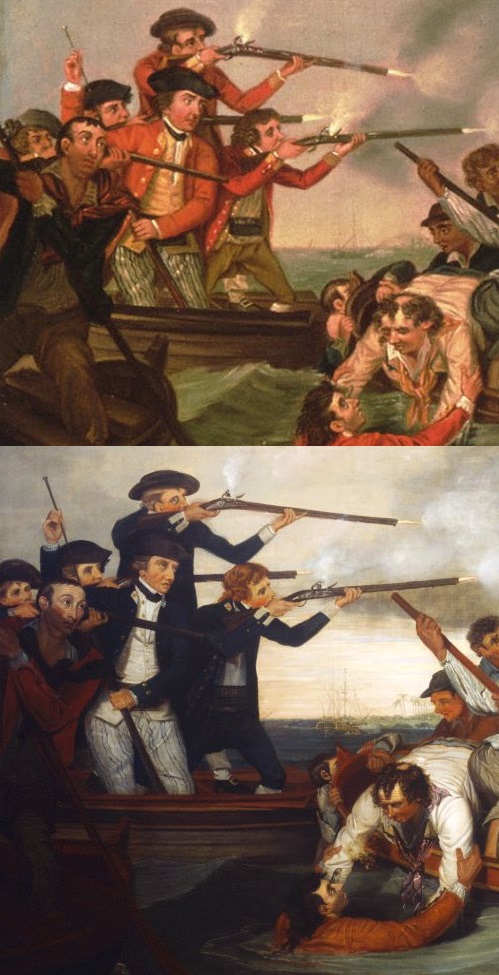Sunday, April 10, 2016
Death of Captain James Cook, 1783
Death of Captain James Cook, George Carter, 1783, Wikimedia Commons.
Death of Captain James Cook, George Carter, 1783, National Library of Australia.
Captain James Cook is arguably the most prominent naval figure of the late eighteenth century. His explorations dramatically expanded Britain's understanding of the world and enabled its dramatic imperial expansion. It is therefore easy to see why his unfortunate end was the subject of numerous artistic depictions in the years following his death. Thanks again to the 18th Century Material Culture Resource Center for pointing me in this direction.
So far as I can tell, there are two separate original pieces done by George Carter in 1783. This was the year the American Revolutionary War ended in favor of the former colonists, and Britain was reeling from the national humiliation. Some of that feeling of despair and helplessness comes through in the worried and distressed expressions of nearly all concerned in these paintings.
At the center of the boat and stepping in is a tar with a black cap, though I can't be certain if it is felt or knit. About his neck is an orange and red neckcloth which hangs over his white jacket. His trousers are of an interesting pattern of blue stripes running vertically along white. What makes them interesting is that the stripes are not of a universal width. In the Wikimedia copy, he wears dark blue stockings, while the NLA copy shows him bare legged.
Near the stern (to the far right beside the naval officer the detail) and clenching his fists is a sailor in a white shirt with narrow blue vertical stripes and natural color trousers that are perhaps canvas. His neckcloth is purple with white dots, and atop his head is a dark cap lined with fur.
Behind him and slightly to the right is a fellow with short hair and a green jacket without a waistcoat. Pushing off with an oar, his mate wears a shirt without neckcloth, waistcoat, or jacket. Cowering in the background is a fellow who is depicted with a white shirt and blue jacket, or a blue shirt. Further forward and reaching out to help a fellow clinging to the bow is a man in a black cap and a brown or blue jacket. Interestingly, the hat style changes from a shovel hat to a round hat between the different paintings. At last, a man reaches over the gunwales to help another sailor. He sports a bald spot and curly hair over a white shirt and orange or purple neckcloth.
One of the more interesting differences between these paintings is the changing of the shooting men from marines to naval officers. the cut of their uniforms is identical, but the color and therefore their role changes. In the details I have just examined, there is a firing line (far less ragged than this) of marines in red coats, so it should not be assumed that these are marines in variant uniforms. This change raises the question as to the artist's original intent for these men, and his decision to change them.
In any case, there's another sailor holding his boat with an oar in the water. In one version, he sports a blue jacket with striped shirt, purple neckcloth, and plain trousers. In the next, he wears a red jacket over a plain shirt with a black neckcloth and plain trousers.
A wealth of details abound in each of these paintings, and I'm sure I've missed a few. Let me know what you spot in the comments below!
Subscribe to:
Posts (Atom)






